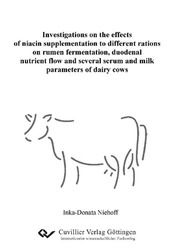| Departments | |
|---|---|
| Book Series (96) |
1378
|
| Nachhaltigkeit |
3
|
| Gesundheitswesen |
1
|
| Humanities |
2362
|
| Natural Sciences |
5406
|
| Mathematics | 229 |
| Informatics | 319 |
| Physics | 980 |
| Chemistry | 1363 |
| Geosciences | 131 |
| Human medicine | 243 |
| Stomatology | 10 |
| Veterinary medicine | 108 |
| Pharmacy | 147 |
| Biology | 835 |
| Biochemistry, molecular biology, gene technology | 121 |
| Biophysics | 25 |
| Domestic and nutritional science | 45 |
| Agricultural science | 1004 |
| Forest science | 201 |
| Horticultural science | 20 |
| Environmental research, ecology and landscape conservation | 148 |
| Engineering |
1790
|
| Common |
97
|
|
Leitlinien Unfallchirurgie
5. Auflage bestellen |
|
Advanced Search
Investigations on the effects of niacin supplementation to different rations on rumen fermentation, duodenal nutrient flow and several serum and milk parameters of dairy cows (English shop)
Inka-Donata Niehoff (Author)Preview
Table of Contents, Datei (42 KB)
Extract, Datei (100 KB)
Due to the incorporation of niacin into the coenzymes NAD and NADP, niacin is of great importance for the metabolism of man and animals. Apart from niacin in feed and endogenous formation, microbial niacin synthesis in the rumen is an important source for dairy cows. But the amount synthesized seems to differ greatly, which might be influenced by the ration fed. Many studies revealed a positive impact of a niacin supplementation on rumen protozoa, but microbial protein synthesis or volatile fatty acid production in the rumen showed inconsistent reactions to supplemental niacin. The amount of niacin reaching the duodenum is usually higher when niacin is fed. But not the whole quantity supplemented reaches the duodenum, indicating degradation or absorption before the duodenal cannula. Furthermore, supplementation of niacin did not always lead to a higher niacin concentration in blood. Effects on other blood parameters have been inconsistent, but might be more obvious when cows are in a tense metabolic situation, for example, ketosis or if high amounts are infused post-ruminally, since ruminal degradation appears to be substantial. The same is valid for milk parameters. In the few studies where blood niacin and milk parameters have been investigated, enhanced niacin concentrations in blood did not necessarily affect milk production or composition.
These results are discussed in the present review, gaps of knowledge of niacin’s mode of action on the metabolism of dairy cows are identified and directions for future research are suggested.
| ISBN-13 (Printausgabe) | 3869551356 |
| ISBN-13 (Hard Copy) | 9783869551357 |
| ISBN-13 (eBook) | 9783736931350 |
| Language | English |
| Page Number | 146 |
| Edition | 1 Aufl. |
| Volume | 0 |
| Publication Place | Göttingen |
| Place of Dissertation | Universität Kiel |
| Publication Date | 2009-11-02 |
| General Categorization | Dissertation |
| Departments |
Agricultural science
|
| Keywords | Dairy cows, nicotinic acid, nicotinamide |








